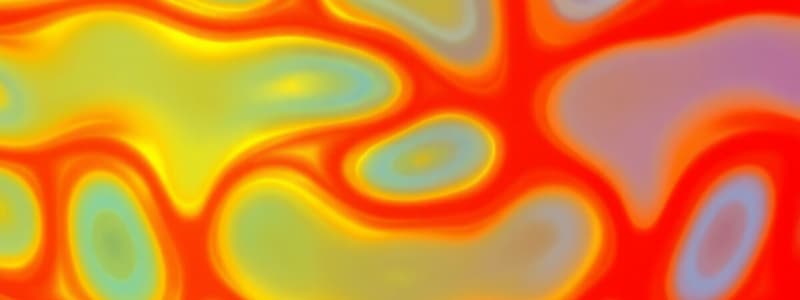Podcast
Questions and Answers
What is meant by constant surface temperature in heat transfer analysis?
What is meant by constant surface temperature in heat transfer analysis?
Constant surface temperature means that the temperature at the surface remains constant over time, denoted as $T(0, t) = T_s$.
What role does Fourier's law play in conduction analysis?
What role does Fourier's law play in conduction analysis?
Fourier's law relates the heat flux to the temperature gradient and is applied after determining the temperature distribution.
How does thermal conductivity impact the conduction of heat in materials?
How does thermal conductivity impact the conduction of heat in materials?
Thermal conductivity measures a material's ability to transfer thermal energy, influencing how quickly heat can be conducted through it.
What is transient heat conduction, and how is it analyzed?
What is transient heat conduction, and how is it analyzed?
In nanoscale conduction, what factors affect energy carrier motion?
In nanoscale conduction, what factors affect energy carrier motion?
What is the general form of the heat flux components in Cartesian coordinates?
What is the general form of the heat flux components in Cartesian coordinates?
How does the heat flux in cylindrical coordinates differ from Cartesian coordinates?
How does the heat flux in cylindrical coordinates differ from Cartesian coordinates?
In spherical coordinates, what affects the heat flux in the angular direction?
In spherical coordinates, what affects the heat flux in the angular direction?
What is the formula for radial heat transfer rate in a cylinder?
What is the formula for radial heat transfer rate in a cylinder?
What does the heat diffusion equation represent in heat transfer analysis?
What does the heat diffusion equation represent in heat transfer analysis?
In the context of transient heat conduction, what factors are considered?
In the context of transient heat conduction, what factors are considered?
How is heat conduction analyzed in multi-dimensional systems?
How is heat conduction analyzed in multi-dimensional systems?
What are boundary conditions in heat transfer analysis?
What are boundary conditions in heat transfer analysis?
What is the relationship between temperature gradient and heat transfer rate?
What is the relationship between temperature gradient and heat transfer rate?
Define the term 'conductive heat transfer'.
Define the term 'conductive heat transfer'.
Study Notes
Constant Temperature Boundary Condition
- Temperature at a surface is equal to a specific value.
- Used to model scenarios where the surface is constantly in contact with a heat source or sink.
Constant Heat Flux Boundary Condition
- Heat flux is specified at a surface.
- Used to model scenarios where a constant amount of heat is being added or removed from a surface.
Convection Boundary Condition
- Accounts for heat transfer between a surface and a fluid.
- Represents convection heat transfer.
Thermophysical Properties
- Thermal conductivity: Material's ability to conduct heat. Higher conductivity means better heat transfer.
- Thermal diffusivity: Material's response to changes in its thermal environment. Higher diffusivity, rapid response.
Nanoscale Effects
- Energy carrier motion is responsible for conduction.
- Mean free path: Average distance traveled by an energy carrier before a collision.
- Energy carriers collide with physical boundaries, influencing their propagation, especially in thin films.
Conduction Analysis
- Microscale or nanoscale effects should be considered in problems involving small physical dimensions or rapid temperature changes.
- Solve the appropriate heat equation to obtain the temperature distribution.
- Apply Fourier's law of heat conduction to determine heat flux.
Heat Flux Components
- Cartesian coordinates: x, y, z
- Cylindrical coordinates: r, , z
- Spherical coordinates: r, ,
- Angular coordinates: Temperature gradient calculated based on temperature change over a length scale, expressed in °C/m.
Heat Rate
- For radial conduction in a cylinder or sphere, heat rate determined by:
- Cylinder: q= Ar qr''=2π rL qr'' [W]
- Sphere: q= Ar qr''=4π r^2 qr'' [W]
Heat Diffusion Equation
- Differential equation that determines the temperature distribution in a stationary medium.
- Based on conservation of energy applied to a differential control volume.
Heat Diffusion Equation (Special Case)
- One-dimensional conduction in a planar medium with constant properties and no generation.
- Equation simplifies to: ∂^2T/∂x^2= 1/α ∂T/∂t
Heat Diffusion Equation (Radial Systems)
- Cylindrical coordinates: 1/r ∂/∂r (kr ∂T/∂r) + 1/r^2 ∂/∂ (k ∂T/ ∂ ) + ∂/∂z (k ∂T/ ∂z) + q'' = ρ cp ∂T/ ∂t
- Spherical coordinates: 1/r^2 ∂/∂r (kr^2 ∂T/∂r) + 1/r^2sin^2 ∂/∂ (k ∂T/ ∂ ) + 1/r^2 sin ∂/∂ (k sin ∂T/ ∂ ) + q'' = ρ cp ∂T/ ∂t
Boundary and Initial Conditions
- Transient conduction requires an initial temperature distribution specification.
- Two boundary conditions must be specified for each coordinate direction due to the second-order nature of the heat equation.
Studying That Suits You
Use AI to generate personalized quizzes and flashcards to suit your learning preferences.
Related Documents
Description
Explore the fundamental concepts of heat transfer boundary conditions, including constant temperature and heat flux conditions, convection, thermophysical properties, and nanoscale effects. This quiz aims to enhance your understanding of how heat interacts with surfaces and fluids in various scenarios.




